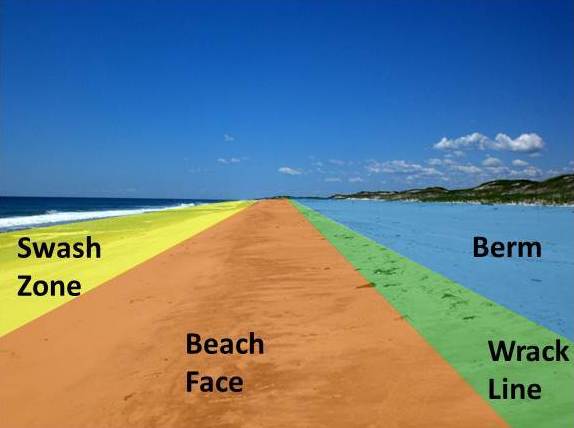A beach is a landform along the shoreline of an ocean, sea, lake, or river. It usually consists of loose particles, which are often composed of rock, such as sand, gravel, shingle, pebbles, or cobblestones. The particles comprising the beach are occasionally biological in origin, such as mollusk shells or coralline algae.
There are several noticeable parts to a beach that relate to the processes that form and shape it. The part mostly above water (depending upon tide), and more or less actively influenced by the waves at some point in the tide, is termed the beach berm. The berm is the deposit of material comprising the active shoreline. The berm has a crest (top) and a face — the latter being the slope leading down towards the water from the crest. At the very bottom of the face, there may be a trough, and further seaward one or more long shore bars: slightly raised, underwater embankments formed where the waves first start to break.
These geomorphic features compose what is called the beach profile. The beach profile changes seasonally due to the change in wave energy experienced during summer and winter months. The beach profile is higher during the summer due to the gentle wave action during this season. The lower energy waves deposit sediment on the beach berm and dune, adding to the beach profile. Conversely, the beach profile is lower in the winter due to the increased wave energy associated with storms. Higher energy waves erode sediment from the beach berm and dune, and deposit it off shore, forming long shore bars. The removal of sediment from the beach berm and dune decreases the beach profile.
The line between beach and dune is difficult to define in the field. Over any significant period of time, sand is always being exchanged between them. The drift line (the high point of material deposited by waves) is one potential demarcation. This would be the point at which significant wind movement of sand could occur, since the normal waves do not wet the sand beyond this area. However, the drift line is likely to move inland under assault by storm waves.
The four sections of most beaches:
1. Swash zone: is alternately covered and exposed by wave run-up.
2. Beach face: sloping section below berm that is exposed to the swash of the waves.
3. Wrack line: the highest reach of the daily tide where organic and inorganic debris is deposited by wave action.
4. Berm: Nearly horizontal portion that stays dry except during extremely high tides and storms. The berm may have sand dunes.

We are going to focus on the wrack zone with this earthcache.
Wrack is washed in by the waves in the sea. Most of the wrack material once was growing offshore before it was cast onshore by the water. Wrack can also be animals and sea life that washes up on the shore. The wrack will help protect the dunes and berm areas. Algae, seaweed, and sea grass are washed on shore and moved further on the beach by wind movement. As the wrack starts to decay, it will provide growth of fungi and other organisms. Many animals will feed on this wrack.
Another important feature of wrack is to provide wind shadows. Clumps of old, decaying wrack will collect the wind-blown sand, shells, and plant seeds that will blow to the upper berm portion of the beach. Plants will grow more quickly during the vulnerable first stages of growth thanks to the nutrients provided by the decaying wrack. This will also allow the sand to stay stable and will form a dune. The dune will help prevent erosion of the shore line. Without the wrack to slow down the erosion by the waves, the beach would continue to erode both back into the sea and further inland in times of storms and strong waves.
Key West does not rake the seaweed that has washed onto the sands of this stretch of ocean beach. A “raked” beach is a destroyed beach. While you may think it’s clean, it is harmful to the beach. Without the wrack and vegetation, the sand cannot form dunes and will easily be blown away.
Basically, wrack is what keeps the beach there for you to enjoy!
Information from Wikipedia.com
To log this earthcache, please send answers to the following questions to my account:
- What evidence of wrack is present on the line today?
- What signs of erosion are evident here?
- Stand with your back to the beach and face the water. To your left, what do you see in the water that will help slow erosion?
- Post a picture of yourself (face not required) or a personal item at the wrack line.